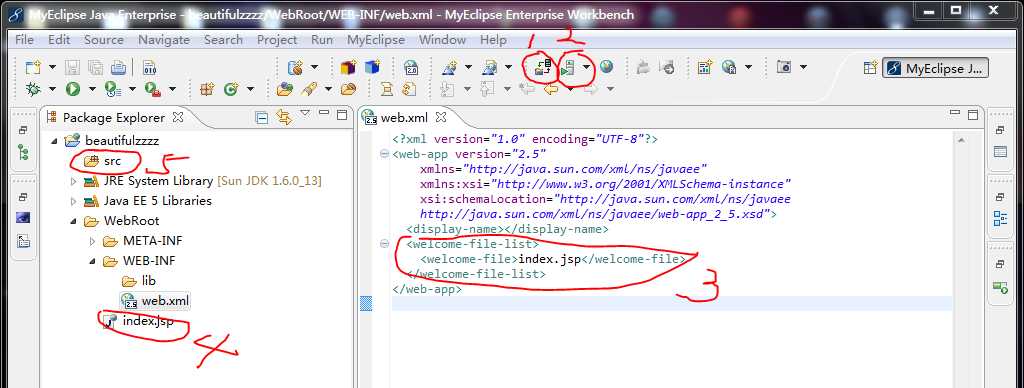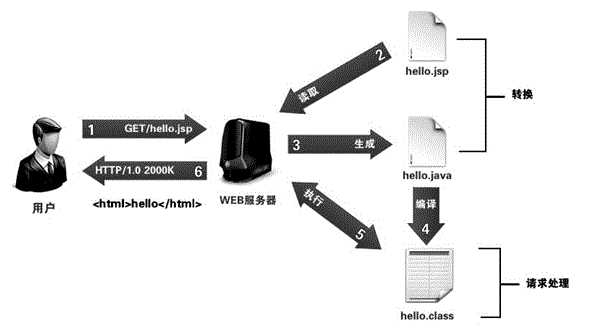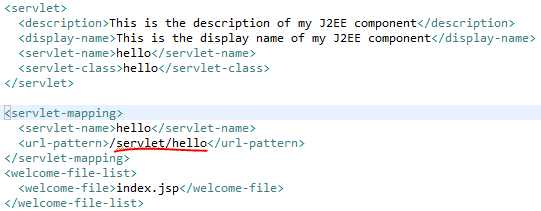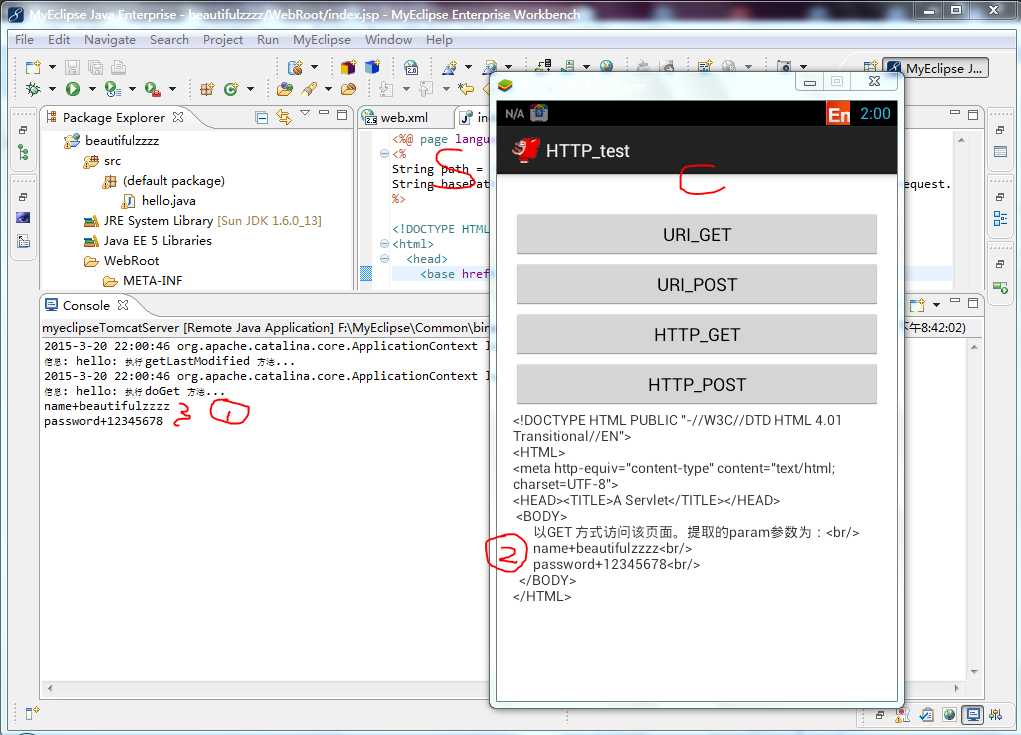标签:
内容简介
本文通过建立一个简单的Servlet服务器来分析安卓上用HTTP和服务器通信的细节,旨在演示C/S模式下服务器端和客户端的工作过程。
目录
part.1 用MyEclipse建立一个简单的servlet服务器
注:这里首先假设您已经正确安装好了MyEclipse及Tomcat并做了相应的配置,可以支持开发并部署一个简单的Java Web工程;假设您已经安装了Eclipse并配置好Android相应开发环境。
part.1 用MyEclipse建立一个简单的servlet服务器
在MyEclipse中File->New->Other->Web Project->Next->Project Name取beautifulzzzz(随便)->Finish,从而新建一个Java Web Project。

在web.xml中<welcome-file-list>标签对中指明了打开网站的首页为index.jsp,接着点击1号按钮选择一个服务器,然后点击2号按钮将web工程部署到该服务器上,然后在浏览器中输入http://localhost:8080/beautifulzzzz/就能看到相应的页面:

现在在src中新建一个名为hello的servlet,并添加相应函数(最终如下):
1 import java.io.IOException; 2 import java.io.PrintWriter; 3 import java.util.Map; 4 5 import javax.servlet.ServletException; 6 import javax.servlet.http.HttpServlet; 7 import javax.servlet.http.HttpServletRequest; 8 import javax.servlet.http.HttpServletResponse; 9 10 public class hello extends HttpServlet { 11 12 /** 13 * Constructor of the object. 14 */ 15 public hello() { 16 super(); 17 } 18 19 /** 20 * Destruction of the servlet. <br> 21 */ 22 public void destroy() { 23 super.destroy(); // Just puts "destroy" string in log 24 // Put your code here 25 } 26 27 /** 28 * The doGet method of the servlet. <br> 29 * 30 * This method is called when a form has its tag value method equals to get. 31 * 32 * @param request 33 * the request send by the client to the server 34 * @param response 35 * the response send by the server to the client 36 * @throws ServletException 37 * if an error occurred 38 * @throws IOException 39 * if an error occurred 40 */ 41 /* 42 * 以Get方式访问页面时执行该函数 执行doGet前会先执行getLastModified,如果浏览器发现getLastModified返回数值 43 * 与上次访问返回数值相同,则认为该文档没有更新,浏览器执行缓存而不执行doGet 如果返回-1则认为是实时更新的,总是执行该函数 44 */ 45 public void doGet(HttpServletRequest request, HttpServletResponse response) 46 throws ServletException, IOException { 47 this.log("执行 doGet 方法..."); 48 this.execute(request, response); 49 } 50 51 /** 52 * The doPost method of the servlet. <br> 53 * 54 * This method is called when a form has its tag value method equals to 55 * post. 56 * 57 * @param request 58 * the request send by the client to the server 59 * @param response 60 * the response send by the server to the client 61 * @throws ServletException 62 * if an error occurred 63 * @throws IOException 64 * if an error occurred 执行前不会执行getLastModified 65 */ 66 public void doPost(HttpServletRequest request, HttpServletResponse response) 67 throws ServletException, IOException { 68 this.log("执行 doPost 方法..."); 69 this.execute(request, response); 70 } 71 72 /** 73 * 返回该Servlet生成文档的更新时间。对Get方法有效 返回的时间为相对于1970年1月1日08:00:00的毫秒数 74 * 如果返回-1表示实时更新。默认为-1 75 */ 76 @Override 77 public long getLastModified(HttpServletRequest request) { 78 this.log("执行 getLastModified 方法..."); 79 return -1; 80 } 81 82 // 执行方法 83 private void execute(HttpServletRequest request, 84 HttpServletResponse response) throws ServletException, IOException { 85 86 response.setCharacterEncoding("UTF-8");// 设置request和response编码,两个都要注意 87 request.setCharacterEncoding("UTF-8"); 88 String requestURI = request.getRequestURI();// 访问Servlet的URI 89 String method = request.getMethod();// 访问Servlet的方式Get或Post 90 // 获得用户提交的所有param 91 Map<String, String> map = request.getParameterMap(); 92 for (String key : map.keySet()) { 93 System.out.println(key + "+" + request.getParameter(key)); 94 } 95 96 response.setContentType("text/html");// 设置文档类型为HTML类型 97 PrintWriter out = response.getWriter(); 98 out.println("<!DOCTYPE HTML PUBLIC \"-//W3C//DTD HTML 4.01 Transitional//EN\">"); 99 out.println("<HTML>"); 100 out.println("<meta http-equiv=\"content-type\" content=\"text/html; charset=UTF-8\">"); 101 out.println("<HEAD><TITLE>A Servlet</TITLE></HEAD>"); 102 out.println(" <BODY>"); 103 out.println(" 以" + method + " 方式访问该页面。提取的param参数为:<br/>"); 104 for (String key : map.keySet()) { 105 out.println(" " + key + "+" + request.getParameter(key) + "<br/>"); 106 } 107 108 out.println(" </BODY>"); 109 out.println("</HTML>"); 110 out.flush(); 111 out.close(); 112 } 113 114 /** 115 * Initialization of the servlet. <br> 116 * 117 * @throws ServletException 118 * if an error occurs 119 */ 120 public void init() throws ServletException { 121 // Put your code here 122 } 123 124 }
这里将doGet和doPost都交给了execute执行,在execute中用request获取请求的相关信息,用response设置返回信息(这样如果用浏览器访问该网页时一般是HTTP的GET或POST请求将触发doGet或doPost函数,然后最终将请求提交给execute执行处理,在execute中获取请求信息并用response的response.getWriter()向客户端写回信息,这里由于是web服务,所以写回的是一个完整的html文档,这样浏览器就能根据返回的文档进行相应显示啦~)

此外,当我们添加一个servlet时会发现web.xml中多了些东西:

包括servlet的name和对应的class,特别重要的是下面的servlet-mapping中的url-pattern,这个指明了访问该servlet的地址:在这里为http://localhost:8080/beautifulzzzz/servlet/hello

摘自园友 lingyun1120的关于安卓HTTP的POST和GET的请求的总结:
lingyun1120的关于安卓HTTP的POST和GET的请求的总结:
1.get是从服务器上获取数据,post是向服务器传送数据。
2.get是把参数数据队列加到提交表单的 ACTION属性所指的URL中,值和表单内各个字段一一对应,在URL中可以看到。post是通过HTTPpost机制,将表单内各个字段与其内容放置 在HTML HEADER内一起传送到ACTION属性所指的URL地址。用户看不到这个过程。
3.对于get方式,服务器端用 Request.QueryString获取变量的值,对于post方式,服务器端用Request.Form获取提交的数据。
4.get 传送的数据量较小,不能大于2KB。post传送的数据量较大,一般被默认为不受限制。但理论上,IIS4中最大量为80KB,IIS5中为100KB。
5.get安全性非常低,post安全性较高。
对于安卓HTTP请求的实现主要有两种方法,一种是传统的HttpURLConnection 方式,另一种是HttpClinet方式。
方式一:HttpURLConnection之GET
1 /*** 2 * 用HttpURLConnection发送Get请求,返回请求字符 3 * @return 4 * @throws IOException 5 */ 6 public String Func1() throws IOException{ 7 // 拼凑get请求的URL字串,使用URLEncoder.encode对特殊和不可见字符进行编码 8 String MyURL=BASE_URL+ "?name=" + URLEncoder.encode("beautifulzzzz", "utf-8") 9 +"&password=12345678";//(好像这里中文不行) 10 URL getUrl = new URL(MyURL); 11 // 根据拼凑的URL,打开连接,URL.openConnection函数会根据URL的类型, 12 // 返回不同的URLConnection子类的对象,这里URL是一个http,因此实际返回的是HttpURLConnection 13 HttpURLConnection conn = (HttpURLConnection) getUrl.openConnection(); 14 15 // 设置连接属性 16 conn.setConnectTimeout(30000);// 设置连接超时时长,单位毫秒 17 18 // 进行连接,但是实际上get request要在下一句的connection.getInputStream()函数中才会真正发到服务器 19 BufferedReader reader = new BufferedReader(new InputStreamReader( 20 conn.getInputStream()));// 取得输入流,并使用Reader读取 21 String result = ""; 22 String line = ""; 23 while ((line = reader.readLine()) != null) { 24 result = result + line+"\n"; 25 } 26 System.out.println(result); 27 reader.close(); 28 conn.disconnect(); 29 return result; 30 }
因为Get请求请求的内容是放在URL中的,所以第8行用BASE_URL和想发送的键值对合成为新的URL,然后根据新合成的URL打开链接获得HttpURLConnection,但是真正的get请求是在connection.getInputStream()函数中才会真正发到服务器的,当该函数执行完时会返回一个输入流,然后我们使用Reader读取该输入流中的内容从而获得服务器的response。
方式二:HttpURLConnection之POST
1 /*** 2 * 用HttpURLConnection发送post请求,返回请求字符 3 * @return 4 * @throws IOException 5 */ 6 public String Func2() throws IOException { 7 URL url = new URL(BASE_URL); 8 // 此处的urlConnection对象实际上是根据URL的 9 // 请求协议(此处是http)生成的URLConnection类 10 // 的子类HttpURLConnection,故此处最好将其转化 11 // 为HttpURLConnection类型的对象,以便用到 12 // HttpURLConnection更多的API.如下: 13 HttpURLConnection conn = (HttpURLConnection) url.openConnection(); 14 15 // 设置连接属性 16 conn.setDoOutput(true);// 使用 URL 连接进行输出 17 conn.setDoInput(true);// 使用 URL 连接进行输入 18 conn.setUseCaches(false);// POST请求不能用缓存 19 conn.setConnectTimeout(30000);// 设置连接超时时长,单位毫秒 20 conn.setInstanceFollowRedirects(true);// URLConnection.setInstanceFollowRedirects是成员函数,仅作用于当前函数 21 // 配置本次连接的Content-type,配置为application/x-www-form-urlencoded的 22 // 意思是正文是urlencoded编码过的form参数,下面我们可以看到我们对正文内容使用URLEncoder.encode 23 // 进行编码 24 conn.setRequestProperty("Content-Type", 25 "application/x-www-form-urlencoded"); 26 conn.setRequestMethod("POST");// 设置请求方式,POST or 27 // GET,注意:如果请求地址为一个servlet地址的话必须设置成POST方式 28 29 OutputStream outStrm = conn.getOutputStream();// 此处getOutputStream会隐含的进行connect 30 DataOutputStream out = new DataOutputStream(outStrm); 31 // 正文,正文内容其实跟get的URL中‘?‘后的参数字符串一致 32 String content = "name=" + URLEncoder.encode("李某人", "utf-8") 33 +"&password="+ URLEncoder.encode("12345678", "utf-8"); 34 // DataOutputStream.writeBytes将字符串中的16位的unicode字符以8位的字符形式写道流里面 35 out.writeBytes(content); 36 out.flush(); 37 out.close(); // flush and close 38 39 // 调用HttpURLConnection连接对象的getInputStream()函数, 40 // 将内存缓冲区中封装好的完整的HTTP请求电文发送到服务端。 41 InputStream inStrm = conn.getInputStream(); // <===注意,实际发送请求的代码段就在这里 42 // 上边的httpConn.getInputStream()方法已调用,本次HTTP请求已结束,再向对象输出流的输出已无意义, 43 // 既使对象输出流没有调用close()方法,下边的操作也不会向对象输出流写入任何数据. 44 // 因此,要重新发送数据时需要重新创建连接、重新设参数、重新创建流对象、重新写数据、 45 // 重新发送数据(至于是否不用重新这些操作需要再研究) 46 BufferedReader reader = new BufferedReader( 47 new InputStreamReader(inStrm)); 48 String result = ""; 49 String line = ""; 50 while ((line = reader.readLine()) != null) { 51 result = result + line+"\n"; 52 } 53 System.out.println(result); 54 reader.close(); 55 conn.disconnect(); 56 return result; 57 }
对于POST请求和GET不同点在于POST的请求正文不是放在URL中。其信息包括请求头和请求正文,所有关于此次http请求的配置都在http头里面定义;对于请求正文content,在connect()函数里面,会根据HttpURLConnection对象的配置值生成http头,因此在调用connect函数之前,就必须把所有的配置准备好(但是如果使用了conn.getInputStream()函数就可以不用使用connect()函数了)。
紧接着http头的是http请求的正文,正文的内容通过outputStream写入,实际上outputStream不是一个网络流,充其量是个字符串流,往里面写入的东西不会立即发送到网络,而是在流关闭后,根据输入的内容生成http正文。
至此,http请求的东西已经准备就绪。在getInputStream()函数调用的时候,就会把准备好的http请求正式发送到服务器了,然后返回一 个输入流,用于读取服务器对于此次http请求的返回信息。由于http请求在getInputStream的时候已经发送出去了(包括http头和正 文),因此在getInputStream()函数之后对connection对象进行设置(对http头的信息进行修改)或者写入 outputStream(对正文进行修改)都是没有意义的了,执行这些操作会导致异常的发生。
注:这里要注意24和35行,如果设置不对会导致服务器无法获取键值对!
注:上面一段参考博客pandazxx的专栏:[Http学习之使用HttpURLConnection发送post和get请求 ]
方式三:HttpClinet之GET
1 /*** 2 * 使用Http的GET请求返回服务器返回结果字符串 3 * 4 * @return 5 * @throws ClientProtocolException 6 * @throws IOException 7 */ 8 public String Func3() throws ClientProtocolException, IOException { 9 HttpGet httpGet = new HttpGet(BASE_URL + "?name=beautifulzzzz" 10 + "&password=1234"); 11 // 获取HttpClient对象 12 HttpClient httpClient = new DefaultHttpClient(); 13 // 连接超时 14 httpClient.getParams().setParameter( 15 CoreConnectionPNames.CONNECTION_TIMEOUT, 30000); 16 // 请求超时 17 httpClient.getParams().setParameter(CoreConnectionPNames.SO_TIMEOUT, 18 30000); 19 HttpResponse httpResp = httpClient.execute(httpGet); 20 String response = EntityUtils.toString(httpResp.getEntity(), "UTF-8"); 21 System.out.println(response); 22 if (response == null) 23 response = ""; 24 return response; 25 }
当使用HttpClient发送Get请求时则相对简单,但是从第9行还是可以看出Get请求的消息还是放在URL中的,特别的这里是实例化一个HttpGet请求,并用HttpClient对象进行相关属性配置,然后调用execute函数获得服务器返回HttpResponse,然后调用getEntity()函数获取Httpresponse实体内容。
方式四:HttpClinet之POST
1 /*** 2 * 使用Http的POST请求返回服务器返回结果字符串 3 * 4 * @return 5 * @throws ClientProtocolException 6 * @throws IOException 7 */ 8 public String Func4() throws ClientProtocolException, IOException { 9 // 將用戶名、密碼和imei封裝到list中,待http發送post請求給服務器 10 NameValuePair pair1 = new BasicNameValuePair("user_name", "涛"); 11 NameValuePair pair2 = new BasicNameValuePair("user_password", 12 "Deddd344"); 13 List<NameValuePair> pairList = new ArrayList<NameValuePair>(); 14 pairList.add(pair1); 15 pairList.add(pair2); 16 HttpPost httpPost = new HttpPost(BASE_URL); 17 HttpEntity requestHttpEntity = new UrlEncodedFormEntity(pairList, 18 HTTP.UTF_8); 19 // 将请求体内容加入请求中 20 httpPost.setEntity(requestHttpEntity); 21 // 获取HttpClient对象 22 HttpClient httpClient = new DefaultHttpClient(); 23 // 连接超时 24 httpClient.getParams().setParameter( 25 CoreConnectionPNames.CONNECTION_TIMEOUT, 30000); 26 // 请求超时 27 httpClient.getParams().setParameter(CoreConnectionPNames.SO_TIMEOUT, 28 30000); 29 30 HttpResponse httpResp = httpClient.execute(httpPost); 31 String response = EntityUtils.toString(httpResp.getEntity(), "UTF-8"); 32 System.out.println(response); 33 if (response == null) 34 response = ""; 35 return response; 36 }
对于HttpClinet发送POST请求,因为键值不是保存在URL中,所以这里要用NameValuePair构建键值对,然后用List<NameValuePair>存储这些键值对,并用此List构建一个HttpEntity实体信息,然后调用httpPost.setEntity(requestHttpEntity);将实体信息加入httpPost中,接着同Get利用execute执行POST请求,然后调用getEntity()获得服务器返回的实体信息。
如下图:本文的安卓客户端分别用上述讲的四种方法向本地的Java Web进行访问,图中显示为执行URI_GET请求时的客户端和服务器后台的效果:点击URI_GET按钮-->客户端启动Quest(1)线程使用Func1()进行Get请求-->当请求结束通过Message将从Func1()返回的服务器返回的Response字符串传送给消息接收句柄,在消息接受句柄中进行对UI中的TextView更新,显示返回结果。而服务器端如part1中介绍,当接收到客户端的POST或GET请求时,都会委托给execute函数来处理,并用PrintWriter out = response.getWriter();将消息发给客户端。

拓展知识均来自网络:请支持原创作者。
http://www.apkbus.com/android-13575-1-1.html
第一种版本:
第二种版本:
第三种版本:
相关链接
此外推荐一些链接帮助更好理解安卓GET和POST请求:
1、我的漫漫程序之旅:[http://www.blogjava.net/supercrsky/articles/247449.html]
内容提示:给出了JDK中的URLConnection参数详解,写的很详细,能帮助理解URLConnection
2、pandazxx的专栏:[http://blog.csdn.net/pandazxx/article/details/1657109]
内容提示:Http学习之使用HttpURLConnection发送post和get请求 ,有例子,有注释
3、上述工程C/S代码:[http://pan.baidu.com/s/1qWqNUos]
4、上述工程GitHub:[https://github.com/beautifulzzzz/Android/tree/master/HTTP_POST_GET]
标签:
原文地址:http://www.cnblogs.com/zjutlitao/p/4353355.html